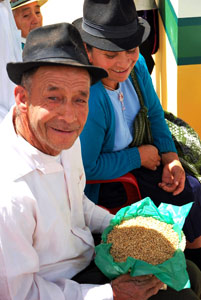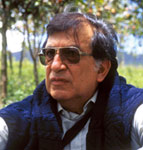 In a determined effort to shield consumers against food price volatility, the government of Ecuador has renewed its investment in food crop research, including a vigorous program to restore wheat production and reduce the nation’s perilous dependence on imported grain.
In a determined effort to shield consumers against food price volatility, the government of Ecuador has renewed its investment in food crop research, including a vigorous program to restore wheat production and reduce the nation’s perilous dependence on imported grain.
The mild irony of putting on a festival to release a drought-tolerant wheat variety after days of unseasonably rainy weather was not lost on Esteban Falconí and Jorge Coronel of Ecuador’s National Institute of Agricultural Research (INIAP). They could not have imagined a more fitting demonstration of the “crazy climate” that has emerged in recent years, altering the long-established weather patterns that govern the cropping season.
In the days before the variety launch, held on 15 July in the Saraguro area of Loja Province, Falconí, who leads INIAP’s cereals program, and Coronel, who heads up the program’s work in southern Ecuador, worried about the bad weather’s real and immediate consequences. Occurring at harvest time (which should have been accompanied by clear skies and intense heat), it threatened to spoil the grain in experimental plots and wreak havoc on farmers’ harvests of wheat, barley, and other crops. The rain also posed a hazard to INIAP’s carefully orchestrated release event.
As luck would have it, the morning of the event, the rains ceased and the harsh Andean sun shown brightly, not only reducing the risk of crop damage but also ensuring that researchers, farmers, political leaders, and other invitees could fittingly celebrate the official arrival of the new wheat, INIAP Vivar 2010 (named after scientist Hugo Vivar). It is among the first products of a campaign launched in 2008 to renew Ecuador’s diminished wheat production.
 A posthumous tribute A posthumous tribute
Deviating just this once from their custom of naming wheat varieties after Ecuador’s highest mountains, researchers dubbed their latest release ‘INIAP Vivar 2010’ in honor of the late Hugo Vivar. He worked as a barley breeder for 16 years with the International Center for Agriculture in the Dry Areas (ICARDA), which posted him at CIMMYT to serve the Latin American region. Subsequently, CIMMYT employed Vivar for another 9 years. A native of Ecuador’s Loja Province, Vivar spent brief periods during his childhood at the family farm in Saraguro. One of the farmers attending an event held to release the new wheat variety recalled that her mother had been one of his playmates. As a scientist, Vivar returned to Saraguro often, helping design a long-term project in collaboration with INIAP, which confronted with remarkable success problems that have kept agricultural productivity low and rural poverty high in this remote mountainous region. |
Having tested Vivar for several years in their own plots, farmers attending the event knew that it would bring higher yields of good-quality grain and offer a buffer against increasingly common drought, another sign of the crazy new climate.
A hole in the food basket
Planted in small plots on steep mountain slopes, Saraguro’s wheat and barley crops appear in the distance like yellow stamps stuck on huge crumpled sheets of green and brown paper.
Against that backdrop, INIAP’s release event celebrated both a new agricultural technology and southern Ecuador’s vibrant rural life. Speeches, displays, and an outdoor banquet drew attention to the new wheat as well as to the region’s rich popular culture, passionate politics, deep religious faith and hard-working people.
Despite the event’s local flavor, it had far-reaching repercussions, including creating public awareness (partly through mass media coverage) of a new technology that represents concrete and rapid progress in an ambitious plan to revive Ecuador’s wheat production.
The plan forms part of this country’s decisive response to the global food price crisis of 2008. Across the developing world, the crisis showed how quickly food security can deteriorate, aggravating the plight of millions of poor and reflecting fundamental weaknesses in the global food system which had been overlooked for years.
In Ecuador, the crisis revealed one gaping hole in an otherwise sturdy basket of staple foods. The country is self-sufficient in rice and produces abundant supplies of beans, cassava, maize, and potatoes. However, Ecuador imports nearly all of its wheat for bread, which figures importantly in the diets of rural and urban consumers alike.
“When wheat prices spiked in 2008, Ecuador’s government cushioned the blow by temporarily subsidizing imported wheat at great cost,” explains Julio César Delgado, INIAP’s director general. Well aware of the flaws in such a policy, he says, government policy makers, at the prompting of president Rafael Correa, sought INIAP’s help in formulating a plan to revitalize wheat production and reduce the country’s excessive dependence on the international wheat market.
| The near-death experience of Ecuador’s wheat sectorThe sector’s marginal status is a relatively recent development. Until the 1970s, farmers in the mountainous regions stretching from the north to the south of the country produced enough wheat to satisfy about half of domestic demand, with the rest being imported. Given the diversity of the country’s agricultural economy and its new income from petroleum, this seemed like a reasonable balance.
But the equilibrium was lost as successive governments, relying heavily on income from petroleum, began to ignore food agriculture as well as the research needed to keep it strong and competitive. Domestic wheat production was particularly neglected, because low international prices and the political clout of the nation’s wheat millers made it easy and profitable to import ever larger quantities of the grain (currently about 5,000 metric tons annually). The resulting decline in Ecuador’s wheat area (from around 100,000 hectares to just a few thousand) precipitated the demise of wheat research. Segundo Ceballos, who labored as a field worker with the cereals program at INIAP’s Santa Catalina Experiment Station from 1966 until 2009, offers a unique perspective on this near-death experience. He vividly recalls the “golden age” of wheat research in the 1970s, when dozens of scientists, technicians, and field workers tended to 15 or 20 hectares planted to international wheat nurseries from CIMMYT, evaluating the new lines and returning the results to center headquarters in Mexico. Norman Borlaug, father of the Green Revolution, visited periodically to observe the team’s progress and to cheer them on. By the turn of the century, however, the work had lost momentum. Only a handful of staff continued sowing a few improved wheat lines each year. They probably would have stopped altogether, says Esteban Falconí, leader of the revitalized national cereals program, were it not for lingering habits and for CIMMYT’s willingness to continue providing the nurseries on request free of charge. |
Resilient wheat for a rugged environment
INIAP itself had suggested such action many times before, but the message had always fallen on deaf ears. Shaken by the 2008 food crisis, the government took the initiative this time, setting out realistic goals and providing about USD 4.3 million over 5 years for intensified wheat research and promotion.
The central aim of the new initiative is to expand Ecuador’s wheat area to about 50,000 hectares, enough to satisfy at least 30% of domestic demand. That would be up from just 3% currently covered by local production. This assumes that farmers will adopt new varieties and apply adequate quantities of fertilizer, for which they will receive credit on reasonable terms.
“A major challenge will be to produce and provide enough improved seed,” says Walter Larriva, director of an INIAP experiment station near the city of Cuenca. The new funding will help, and so will INIAP’s years of experience in helping establish farmer seed production groups, he explains.
Less than two years after the 2008 decision to renew Ecuador’s wheat research and production, INIAP is already releasing improved varieties, including Vivar for southern Ecuador and San Jacinto (released later in July, along with a new barley variety) for the country’s central and northern zones. Those are the first wheat varieties to be released in Ecuador since the early 1990s, when Cojitambo became available. Much of the country’s limited wheat area is planted to that and older varieties.
Vivar is far more resilient than its predecessors under rugged conditions, offering a consistent yield advantage of about 80%. Based on a line developed by CIMMYT and named Berkut, it was introduced into Ecuador during 2003. Vivar’s good tolerance to drought probably comes from a line in its pedigree that resulted from crosses made at CIMMYT between domesticated wheat and related wild species. The excellent performance of the new variety bodes well for INIAP’s initiative to reduce Ecuador’s dependence on imported wheat, but it could generate further benefits as well.
One of the farmers present at the release, Patricio Ordóñez, describes how he invested extra income from improved wheat in the production of high-value tropical fruits. Ordóñez is one of more than a dozen community leaders trained under a project carried out jointly by INIAP and CIMMYT in Saraguro from 1995 to 2008, with the aim of reducing rural poverty through more diverse and sustainable agricultural systems.
A renaissance of research results
INIAP was able to release Vivar and San Jacinto so soon after the start of the new national wheat initiative for two reasons. One was CIMMYT’s unswerving support for local wheat research even during its time of relative dormancy in Ecuador. If that service had ceased, INIAP’s new wheat team would have been forced to start essentially from scratch, adding many years to the process of variety development.
Just as important was the government’s decision in the wake of the food crisis to thoroughly refurbish INIAP’s research infrastructure as well as to hire and train dozens more scientists and technicians.
“Many years of neglect,” says Delgado, “had left our facilities in a poor state and had undermined the ability and motivation of our scientists to deliver results.” As director general, Delgado’s main achievement was to restore what he refers to as “la mística del trabajo” (or work ethic), leading to a renaissance of research results, as demonstrated by Vivar and other new varieties.
Segundo Ceballos, who worked in INIAP’s barley and wheat plots for more than four decades, is very happy about the new varieties and the wheat research revival. For they vindicate years of struggle to keep a central pillar of his country’s food security from falling.
For further information: Hans Braun, director, global wheat program (h.braun@cgiar.org)
 Capacity development
Capacity development 
